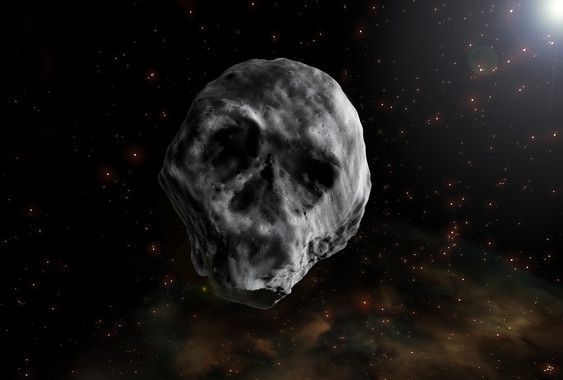
Alas, poor 2015 TB145, which by a twist of fate immediately and irrevocably became nicknamed the "Halloween asteroid" after its skull-like form skimmed 300,000 miles away from Earth on October 31, 2015. That's just a little bit farther away from Earth than the distance at which the moon orbits us. But one visit wasn't enough for this space rock, which will visit our neighborhood again next November.
The asteroid's flyby in 2015 allowed scientists to become more familiar with its infinite scientific jests, like the fact that it measures about 2,100 feet across. That, plus its orbital path, make it, according to NASA, a Potentially Hazardous Asteroid (PHA), living up to its spooky nickname.
The scientists also tried to pin down more clues to the asteroid's life. Much of the secret to studying asteroids lies in catching its flashes of reflected light. That lets scientists estimate, for example, at what speed it rotates as it hurtles through space—likely turning about once every three hours in this object's case, although some data suggest it may be more like once every five hours.
Those flashes were few and far between, however, since the surface of 2015 TB145 is painted thick with molecules that reflect only 5 or 6 percent of the light that hits it. "This means that it is very dark, only slightly more reflective than charcoal," Pablo Santos-Sanz, an astronomer at the Institute of Astrophysics of Andalusia, told Spanish news agency SINC.
The scientists got a sense of the object's path, determining it traces an oval that loops from, at one end, perilously close around the sun (even closer than Mercury orbits it), to out past Jupiter. Even though 2015 marked the first time scientists spotted it, they believe it's an ancient object.
But then, just two weeks after scientists began studying it, 2015 TB145 slipped out of range of telescopes, putting an end to its gibes and gambols. The asteroid was first spotted by Pan-STARRS, a Hawaiian telescope that two years later caught scientists' first glimpse of a similar object that hailed from another solar system.
But unlike so many other skull-shaped objects, 2015 TB145 is far from dead: Scientists have also figured out that 2015 TB145 is doomed to visit Earth again next November, when it will skim past Earth at about a quarter of the distance as that to the sun. Astronomers are now gearing up to meet it again to gain a still better sense of what's happening on this giant cosmic skull.
Uncommon Knowledge
Newsweek is committed to challenging conventional wisdom and finding connections in the search for common ground.
Newsweek is committed to challenging conventional wisdom and finding connections in the search for common ground.
About the writer
Meghan Bartels is a science journalist based in New York City who covers the science happening on the surface of ... Read more
To read how Newsweek uses AI as a newsroom tool, Click here.








